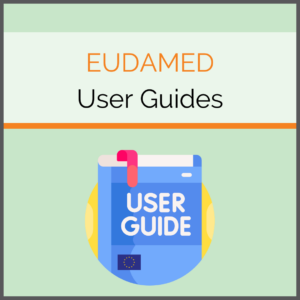
EUDAMED stands for European Database on Medical Devices. It was introduced as part of the Medical Device Regulation (MDR) and the In vitro Diagnostic Medical Device Regulation (IVDR). Manufacturers register their products here and store all relevant data such as certificates and studies. Thanks to this database, patients can easily access information about the medical devices they use, which leads to greater transparency. EUDAMED is due to become fully functional in 2027 and its use will be mandatory for manufacturers two years later. The European Commission regularly publishes EUDAMED user guides to help users learn how to operate the database by 2029.
Since the activation of the first module, the EU Commission has published nine different user guides. Here, individual steps are presented in the form of screenshots. The guides are divided into the categories of actors, modules, and data exchange. In the following article we would like to present the individual user guides.
Actors
So far, EUDAMED user guides have been published for the Actor Validation for Competent Authorities, as well as the roles of Designated Authorities, Economic Operators, and Notified Bodies. The category revolves around creating the correct user profile for the respective roles. Therefore, these user guides start uniformly with the creation of an account in EUDAMED.
Actor Validation for Competent Authorities
This EUDAMED user guide provides a comprehensive overview of the validation process for competent authorities. It covers everything from starting and ending an EUDAMED session to validating access requests for actor registration. It also shows how Competent Authorities request correct access to EUDAMED. Further attention is paid to the various user roles. This includes the hierarchical relationships between the Local Actor Administrator (LAA), Local User Administrator (LUA), Validator, and Viewer.
Designated Authorities
The Designated Authorities’ guide is intended to help them understand how to use the EUDAMED platform for their specific tasks. First, it outlines the validation process for the first LAA account of a Notified Body. Additionally, it discusses the management of access requests from internal users and the suspension or withdrawal of access requests. The guide contains instructions on how to gain access to the EUDAMED platform. It covers everything from starting and ending an EUDAMED session to understanding user profiles and access authorizations.
Economic Operators
The guide for Economic Operators describes in detail how to use the module for user registration. It also covers the management and access of user accounts and their respective roles. The registration of Economic Operators outside the EU is also covered. This guide is particularly useful for manufacturers, authorized representatives, importers, and manufacturers of system and procedure packs who wish to register their products in EUDAMED.
Notified Bodies
The EUDAMED user guide for Notified Bodies is the shortest in the category of actors. It contains instructions on how to gain access to the EUDAMED platform. It covers everything from starting and ending an EUDAMED session to understanding user profiles and access authorizations.
Modules
In this category, you will find guides corresponding to the six EUDAMED modules. However, with Notified Bodies and Certificates, Legacy Devices, and UDI Devices, only three different files are available so far. The last two also deal with the UDI registration module.
Legacy Devices
The guide for legacy devices contains detailed instructions on how these devices can be identified, registered, and managed in EUDAMED. It covers everything from creating the identification details for a legacy device to managing the product information.
Notified Bodies and Certificates
This guide provides an overview of the registration process for certificates in EUDAMED. The guide includes an introduction to the different types of certificates according to MDR and IVDR. It also shows how to register and update an issued or rejected certificate. Their management and the management of the Summary of Safety and Clinical Performance (SSCP) can also be found here.
UDI Devices
Within this guide, the registration and management of medical devices and system and procedure packs are described. Furthermore, it explains in detail how Basic UDI-DIs and UDI-DIs for the respective products are entered in EUDAMED. This includes the creation of identification details through to the management of device information. The module’s search function, including various filters, is also explained.
Data Exchange
The various upload options are presented in this section.
Guidelines on Data Exchange
“Guidelines for data exchange” provides a comprehensive overview of the various types of data input. The guidelines help to find the ideal solution for the user’s needs. Manual upload via the EUDAMED user interface, XML bulk upload, and machine-to-machine solutions are presented.
Machine-to-Machine
This user guide focuses exclusively on machine-to-machine (M2M) data exchange for EUDAMED. Elements included in this guideline are the general structure of an M2M connection, the requirements for use, onboarding, and the data exchange process. Furthermore, tips are given on how many products the respective upload variants are recommended for.
The complexity of EUDAMED is no secret. The European Commission’s nine user guides are therefore a welcome help for its users. They serve as an introduction, but cannot cover all facets of the medical device database. For example, there are currently no guides for four of the six modules. It therefore remains to be seen whether further EUDAMED user guides will follow in the future.
All previous guides can be viewed in the EUDAMED information centre.
[Disclaimer]
This information is only one possible interpretation of the regulations. They are also in a constant state of change, so the information in this article may be incomplete or out of date. The above article is expressly no legal advice. Please refer to the official documents for information before making any business decisions. (Status of information: June 2024)